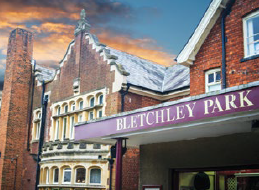 In most cinematic renditions of World War II, the main events are illustrated with explosions and guns and soldiers bunkered down on the Western front. Movies portray war heroes like General Patton, MI6 spies like James Bond. Yet not all of the Allied achievements were action-packed and explosive enough to grace the silver screen with the likes of Daniel Craig. Some of the most important developments of the war were orchestrated behind the scenes, by the least likely of heroes.
In most cinematic renditions of World War II, the main events are illustrated with explosions and guns and soldiers bunkered down on the Western front. Movies portray war heroes like General Patton, MI6 spies like James Bond. Yet not all of the Allied achievements were action-packed and explosive enough to grace the silver screen with the likes of Daniel Craig. Some of the most important developments of the war were orchestrated behind the scenes, by the least likely of heroes.
In reality, one of the greatest military feats of World War II took place not on a battlefield, but on a secluded estate 40 miles out of London, strategically located just between Oxford and Cambridge universities. And the enlistees were not rugged soldiers or dashing spies, but a motley crew of chess champions, math professors, and crossword lovers, more akin to Stephen Hawking than the archetypal war hero. Thus began the military legacy of Bletchley Park, the brains behind many of the most important strategic maneuvers of World War II.
Bletchley Park’s enigmatic military legacy began in August 1938, when it was visited by “Captain Ridley’s Shooting Party.” Seemingly on holiday, the party actually consisted of members of MI6 and the Government Code and Cypher School (GC&CS), who were scoping out the location for a large-scale wartime government intelligence operation. By September 1939, the Nazi invasion was in full swing, and so was Bletchley Park.
The mission: to crack all Nazi codes and cyphers. The means: a number of England’s most brilliant cryptologists, linguists, and mathematicians. The cipher: the Enigma Code. Just before the German invasion, the Polish had enlisted help from Britain to crack this seemingly impossible cipher made by Germany’s Enigma Machine, which changed at least once a day and had 159 million million million settings.
In order to infiltrate Nazi communications made via the Enigma Machine, the British secret service knew they would have to use every resource they could find. So they summoned the best, most renowned puzzle-solving geniuses from Oxford and Cambridge and stationed them in wooden huts around the estate, referring to each division by hut number for the sake of security. A hodgepodge medley of eccentrics, the code-breakers became known as “Boffins and Debs,” and the GC&CS was nicknamed the “Golf, Cheese & Chess Society.” Even Winston Churchill, on a visit to Bletchley, said to Denniston, “I told you to leave no stone unturned to get staff, but I had no idea you had taken me so literally.” Yet despite the jokes they inspired, the unique minds at Bletchley proved invaluable before long.
It has now been estimated that the war was reduced by two years due to the work at Bletchley Park. Kept secret for years after World War II, Bletchley Park is now a full-fledged historical attraction open to visitors across the world.
Want to visit Bletchley Park? Add a visit to any of the London Itineraries like the London Theater tour.
